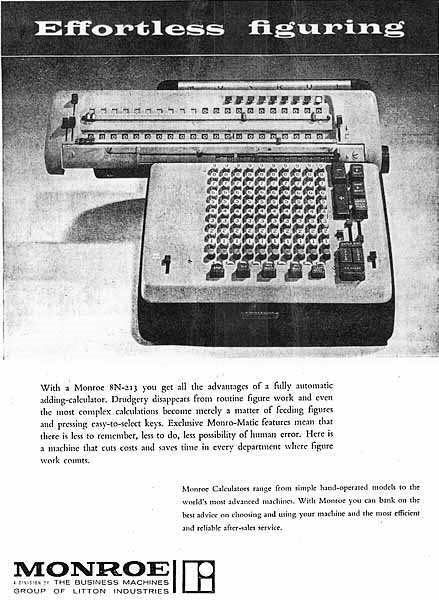Electronic Calculators We Amazing Devices
In the past, mechanical clerical aids such as abaci, comptometers, Napier's bones, books of mathematical tables, slide rules, or mechanical adding machines were used for numeric work. The word "calculator" denoted a person who did such work for a living using such aids as well as pen and paper. This semi-manual process of calculation was tedious and error-prone.
Modern calculators are electrically powered and come in countless shapes and sizes varying from cheap, give-away, credit-card sized models to more sturdy adding machine-like models with built-in printers.
On Apollo
Do not laugh! I used these on the Apollo Program to figure out technical problems! The mechanizal ones would grind for hours to solve relatively simple problems!
 From the early 1900s through the 1960s, mechanical calculators dominated the desktop computing market (see History of computing hardware). Major suppliers in the USA included Friden, Monroe, and SCM/Marchant. (Some comments about European calculators follow below.)
From the early 1900s through the 1960s, mechanical calculators dominated the desktop computing market (see History of computing hardware). Major suppliers in the USA included Friden, Monroe, and SCM/Marchant. (Some comments about European calculators follow below.)
These devices were motor-driven, and had movable carriages where results of calculations were displayed by dials. Nearly all keyboards were full — each digit that could be entered had its own column of nine keys, 1..9, plus a column-clear key, permitting entry of several digits at once. (See the illustration of a 1914 mechanical calculator.) One could call this parallel entry, by way of contrast with ten-key serial entry that was commonplace in mechanical adding machines, and is now universal in electronic calculators.
(Nearly all Friden calculators had a ten-key auxiliary keyboard for entering the multiplier when doing multiplication.) Full keyboards generally had ten columns, although some lower-cost machines had eight. Most machines made by the three companies mentioned did not print their results, although other companies, such as Olivetti, did make printing calculators.
In these machines, Addition and subtraction were performed in a single operation, as on a conventional adding machine, but multiplication and division were accomplished by repeated mechanical additions and subtractions. Friden made a calculator that also provided square roots, basically by doing division, but with added mechanism that automatically incremented the number in the keyboard in a systematic fashion. Friden and Marchant (Model SKA) made calculators with square root. Handheld mechanical calculators such as the 1948 Curta continued to be used until they were displaced by electronic calculators in the 1970s
The Move To Electronic

The electronic calculators of the mid-1960s were large and heavy desktop machines due to their use of hundreds of transistors on several circuit boards with a large power consumption that required an AC power supply.
There were great efforts to put the logic required for a calculator into fewer and fewer integrated circuits (chips) and calculator electronics was one of the leading edges of semiconductor development.
U.S. semiconductor manufacturers led the world in Large Scale Integration (LSI) semiconductor development, squeezing more and more functions into individual integrated circuits.
This led to alliances between Japanese calculator manufacturers and U.S. semiconductor companies: Canon Inc. with Texas Instruments, Hayakawa Electric (later known as Sharp Corporation) with North-American Rockwell Microelectronics, Busicom with Mostek and Intel, and General Instrument with Sanyo.
 Computers Were In Their Infancy
Computers Were In Their Infancy